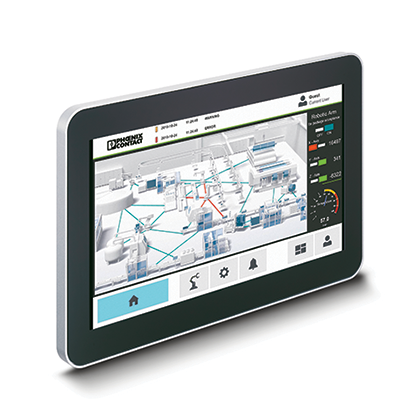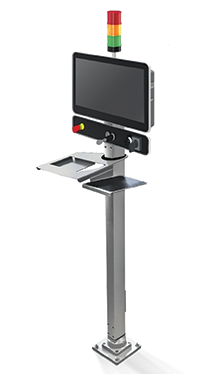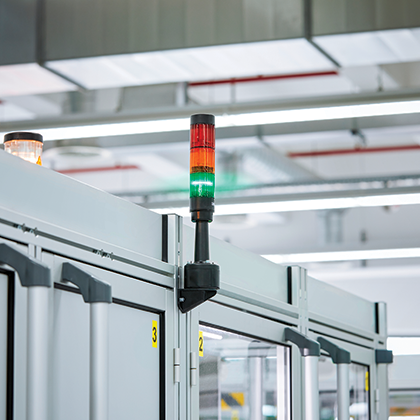

Industrial PCs are indispensable in factory automation. In times of increasing digitalisation, they take care of a variety of tasks. That’s why it’s important that the devices can be easily installed, operated, and extended, support state-of-the-art (communications) technologies, and also work reliably under harsh conditions – just like the AIO product family from Phoenix Contact does. Faced with ever-growing challenges involving Industry 4.0, companies are looking for features which will make their machines and systems stand out against solutions from other competitors. In addition, the concepts should be able to be integrated easily and quickly into the existing production systems of factory automation.
Many manufacturers have identified optimisation of the operating terminals as a possible starting point toward overcoming the extreme challenges, for example with regard to data transmission in the gigabit range or use of the Profinet protocol for communication.
Moreover, the display and controls need to be able to be arranged flexibly, be extendable, and also be able to withstand the harsh industrial ambient conditions. In addition, the hardware and software need to be designed to be cost-effective and to function reliably. Last but not least, a clearly structured and intuitive-to-operate visualisation is needed so that the handling and training effort can be kept simple.
That is why Phoenix Contact offers industrial PCs with a completely closed housing (degree of protection, IP65) in an appealing design in its all-in-one solutions (AIO). They are ideally suited for forward-looking operating concepts due to their powerful technology, modular extendibility, and integrated Profisafe functionality.

Robust design for the harsh industrial environment
With multitouch operation, which today can be implemented almost exclusively using a projective capacitive touchscreen (referred to as PCT or PCAP), the necessary sensors are installed behind a pane of glass. Therefore, the functionality of the touchscreen is not impacted by external forces and does not accumulate wear.
Phoenix Contact uses the latest generation of sensors in its AIO devices. They allow the screen to be operated even while wearing thick gloves, which expands the range of application for the devices even further. Omitting the plastic film that is attached to the front of the glass in a resistive touch device further increases the robustness of the capacitive technology with regard to aggressive cleaning agents and sharp objects. The glass pane therefore provides a robust front that is particularly useful for applications in harsh industrial environments. In addition, the glass pane can extend over the entire front of the panel PC. This opens up new options for the design and creates added value in the external appearance of the system.
The advantages of the projective capacitive touch technology have already been incorporated into the design of the current full IP65 AIO product family. Displays in 15,6-inch, 18,5-inch, or 21,5-inch sizes with a full HD resolution of 1920 x 1080 pixels provide enough space to visualise the complete bandwidth ranging from simple sequences to complex manufacturing processes. And if there is still not enough space, then the user can quickly make the desired detail visible on the display using gesture control (Figure 1).

Powerful processors in a fanless design
State-of-the-art and graphics-intensive visualisations do, however, require powerful CPUs to ensure smooth operation. Therefore, the new AIO devices contain powerful Intel Core i5 processors so that they are particularly suitable for tasks that are very demanding, such as those that arise in machine control, process visualisation, quality assurance, or data acquisition.
Despite the high-performing CPUs, the panel PCs are passively cooled; in other words, they are designed to be completely fanless, which massively increases their range of applications and the system availability. This is because the devices do not emit dust, splash water, or oil. Moreover, they require significantly less maintenance, and the noise from the fan is also eliminated.
In addition, the industrial PCs in the AIO product family work exclusively with Intel long-term roadmap processors which have been on the market for a long time and have low power loss. Using them ensures that we can deliver a device that is compatible with its function over a time period of many years. Nevertheless, if there are updates or other adaptations that are pending, the person in charge of the setup can still carry out all the necessary installation and maintenance measures using the IP65-protected USB port.

Various mounting options for every application area
As already mentioned, the AIO devices have a completely closed aluminium die-cast housing with IP65 protection, which is why there is no need for an additional enclosure or a control cabinet installed on the machine. This saves valuable space.
Furthermore, the panel PCs are equipped with a VESA-100 mounting hole on the rear of the housing. This allows it to be attached directly to the machine or the system, for example to a VESA wall bracket. If assembly on a supporting arm or a pedestal is required, then a suitable back cover for the housing is also available (Figure 2).
The compact dimensions are an additional advantage of the AIO family: the series has a depth of just 100 millimetres. Large and expensive enclosures or control cabinets, which are particularly needed for large widescreen displays, and the resulting installation by two employees, are therefore a thing of the past. This reduces the costs for mounting significantly (Figure 3).

Many extension options in one comprehensive operating terminal
In the AIO product family, the well thought-out design and the associated offerings from Phoenix Contact don’t just end at operator panels. If desired, the industrial PC user can add a keypad module which allows the integration of up to eleven buttons or switches with a size of 22,5 millimetres. The buttons can be used for USB connections, key switches, or other functions, for example. Even an emergency stop or selector switch can be integrated directly into the operating concept. Gaps that are not needed can be used later or simply left unused (Figure 4).
If the user would like to integrate the operating solution (including the keypad module) in an existing Profinet network, there is a gigabit-capable switch with Profinet and Profisafe functionality available to forward the data. And if a signal tower is to be mounted to the machine or system, it can be added into the operating concept without problems. In addition, Phoenix Contact offers a complete operating terminal, including pedestal, keyboard, mouse, and internal wiring.

Optional integration of modular signal towers
Signal towers, which are likewise available from Phoenix Contact, can also be integrated into the AIO product family operating concept. The optical or acoustic signalling increases the availability of the machine or system. The structure of the towers can be adapted to various requirements easily and without tools, thanks to the modular ability to combine five colours and various signal output types.
The selected signal elements are simply plugged together. They are connected mechanically and electrically by twisting with the bayonet lock. The cable is then connected to the bottom tower element. The signal tower itself works reliably in harsh industrial environments due to the IP65 degree of protection (Figure 5).
| Tel: | +27 11 801 8200 |
| Email: | [email protected] |
| www: | www.phoenixcontact.co.za |
| Articles: | More information and articles about Phoenix Contact |
© Technews Publishing (Pty) Ltd | All Rights Reserved